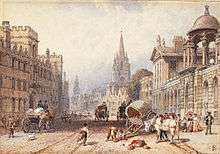History of Oxford
The history of Oxford in England dates back to its original settlement in the Saxon period. Originally of strategic significance due to its controlling location on the upper reaches of the River Thames at its junction with the River Cherwell, the town grew in national importance during the early Norman period, and in the late 12th century became home to the fledgling University of Oxford.[1] The city was besieged during The Anarchy in 1142.[2]

The University rose to dominate the town entirely, and by the middle of the 14th century the history of the town was effectively no more than a footnote to the history of the university. A heavily ecclesiastical town, Oxford was greatly affected by the changes of the English Reformation, emerging as the seat of a bishopric and a full-fledged city. During the English Civil War, Oxford housed the court of Charles I.
The city began to grow industrially during the 19th century, and had an industrial boom in the early 20th century, with major printing and car-manufacturing industries. These declined, along with other British heavy industry, in the 1970s and 1980s, leaving behind a city which had developed far beyond the university town of the past.[3]
See also
References
- "A brief history of the University". University of Oxford. Retrieved 17 August 2012.
- Crouch, D. (2013). The Reign of King Stephen: 1135-1154 (2nd ed.). London: Routledge. p. 203. ISBN 978-1-31789-297-7.
- Curl, James Stevens (1977). The Erosion of Oxford. Oxford Illustrated Press Ltd. ISBN 0-902280-40-6.
Bibliography
Published in the 19th century
- George Alexander Cooke (1800), "Oxford", Topographical and statistical description of the county of Oxford, London: Printed for C. Cooke, OL 7126442M
- J.N. Brewer (1813), "Oxford", Beauties of England and Wales, 12, London: J. Harris, hdl:2027/yale.39002040781982
- New Pocket Companion for Oxford, Oxford: Printed for J. Cooke, 1814, OCLC 43132323, OL 20441538M
- James Ingram (1837), Memorials of Oxford, Oxford: J. H. Parker
- "Oxford", Great Western Railway Guide, London: James Wyld, 1839, OCLC 12922212
- Oxford University and city guide, on a new plan, Oxford: Henry Slatter, 1841, OL 13510937M
- "Oxford", Black's Picturesque Tourist and Road-book of England and Wales (3rd ed.), Edinburgh: Adam and Charles Black, 1853
- Theodore Alois Buckley (1862), "Oxford", Great Cities of the Middle Ages (2nd ed.), London: Routledge, Warne, & Routledge
- James J. Moore (1878), Historical handbook and guide to Oxford (2nd ed.), Oxford: T. Shrimpton and Son, OL 6296488M
- Edward C. Alden (1890), Alden's Oxford Guide (16th ed.), Oxford: Alden & Co., OCLC 10923077, OL 23324274M
- "Oxford", Great Britain (4th ed.), Leipsic: Karl Baedeker, 1897, OCLC 6430424
- Charles Gross (1897). "Oxford". Bibliography of British Municipal History. New York: Longmans, Green, and Co.
- Visitor's guide to Oxford, Oxford: Parker & Co., 1897, OCLC 13779765, OL 25410017M
Published in the 20th century
- Andrew Lang (1906). Oxford. Boston: Cornhill Publishing Co. OL 13507496M.
- Cecil Headlam (1907). The story of Oxford. London: Dent & Co. OL 14043719M.
- Rhoda Murray (1912). The making of Oxford. Oxford: B.H. Blackwell. OL 25402026M.
- Edward Godfrey Cox (1949). "Cambridge and Oxford". Reference Guide to the Literature of Travel. 3: Great Britain. Seattle: University of Washington. hdl:2027/mdp.39015049531448 – via Hathi Trust.
- W. N. Hargreaves-Mawdsley (1973). Oxford in the Age of John Locke. Centers of Civilization Series. USA: University of Oklahoma Press. OL 5284855M.
- A. R. Woolley (1975). The Clarendon Guide to Oxford (3rd ed.). Oxford University Press. ISBN 0-19-951047-4.
- Christopher Hibbert, ed. (1988). The Encyclopaedia of Oxford. Macmillan. ISBN 0-333-39917-X.
Published in the 21st century
- Daniel A. Bell; Avner de-Shalit (2011), "Oxford", Spirit of Cities: Why the Identity of a City Matters in a Global Age, Princeton, NJ: Princeton University Press, ISBN 9780691151441